





Head Banging – Social Story for Safe Alternatives & Self-Regulation
₹80
₹160
50% off
0 (0 ratings)
Grade Levels
Pre-K - Grade 3 (Ages 4-9)
Content Overview
Format: Printable PDF, Total Pages: 11, Features: 16 real-life segments, engaging illustrations, 6 interactive activities
Categories
Pages from the Resource
This social story helps children who engage in head banging by teaching safe and effective self-regulation strategies. Using real-life scenarios and interactive activities, kids learn why they feel the urge to bang their head and how to express emotions in a safer way. Designed for kids with autism, ADHD, and sensory processing challenges.

Page 1

Page 2
What Users Say
0
0 ratings
5
0+
4
0+
3
0+
2
0+
1
0+
5 Stars
Product is Good to use.
10 months ago
Varsha Parent
Similar Products
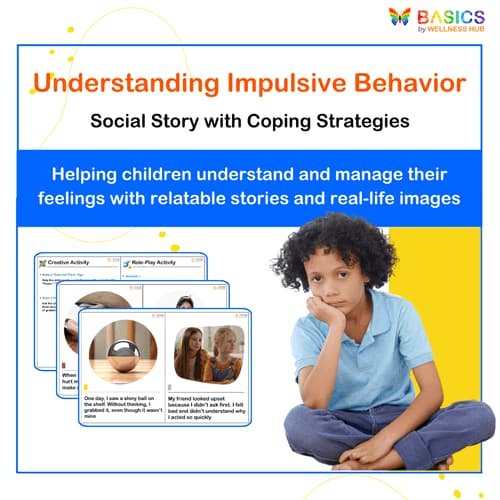
Understanding Impulsive Behavior: Social Story with Coping Strategies
₹ 80.00
₹ 160.00
50% off
4.9 (42 ratings)
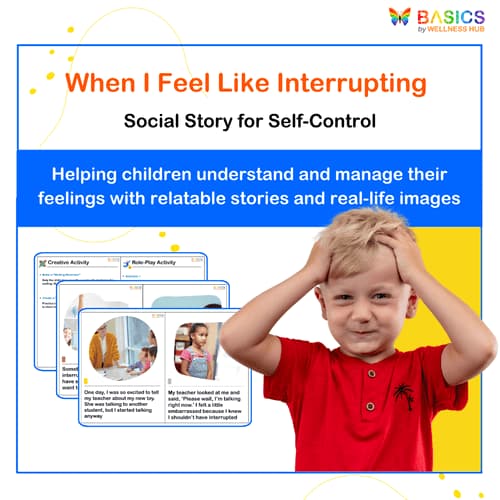
When I Feel Like Interrupting – Social Story for Self-Control
₹ 80.00
₹ 160.00
50% off
4.8 (60 ratings)
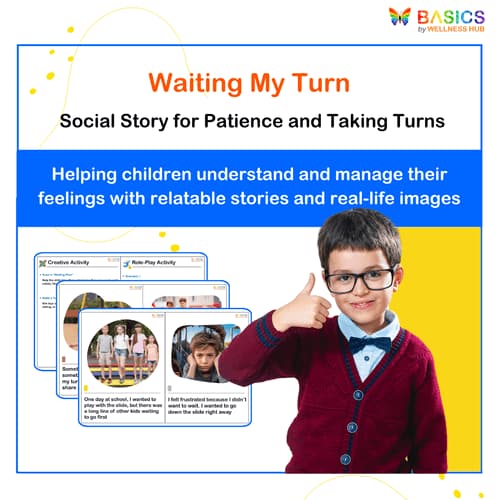
Waiting My Turn – Social Story for Patience and Taking Turns
₹ 80.00
₹ 160.00
50% off
4.7 (56 ratings)
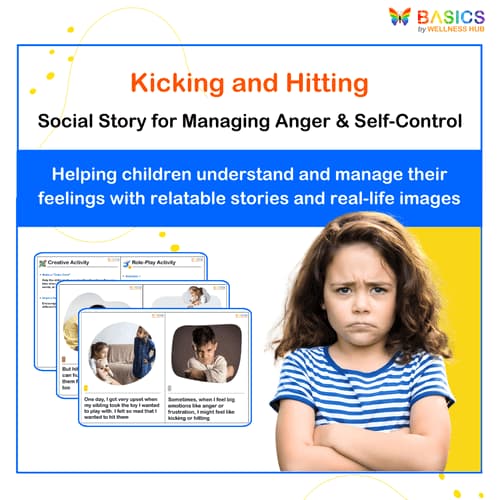
Kicking and Hitting – Social Story for Managing Anger & Self-Control
₹ 80.00
₹ 160.00
50% off
4.6 (52 ratings)
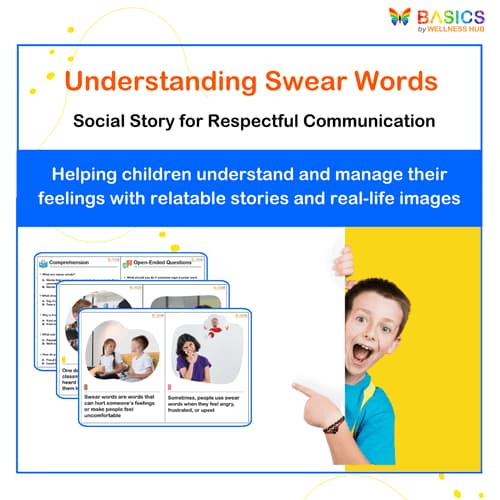
Understanding Swear Words – Social Story for Respectful Communication
₹ 80.00
₹ 160.00
50% off
4.9 (48 ratings)
About the Product
Head banging is a behavior seen in many young children, particularly those with autism, ADHD, sensory processing difficulties, or emotional regulation challenges. While head banging may serve as a form of self-soothing, communication, or response to frustration, it can be concerning for parents, teachers, and therapists.
This social story is designed to help children understand why they engage in head banging and provide safe alternatives to express their emotions. Through first-person storytelling, engaging illustrations, and interactive activities, children learn self-regulation strategies that encourage healthier coping mechanisms.
This resource is ideal for:
✔ Preschoolers and early learners who struggle with impulse control.
✔ Children with autism, ADHD, and sensory processing issues who use head banging as a calming mechanism.
✔ Parents, teachers, and therapists looking for structured tools to teach safe self-regulation skills.
By reinforcing positive coping strategies, this social story helps children transition from unsafe behaviors to healthy emotional expression, ensuring their safety and well-being.
Product Details
- Format: Printable PDF
- Total Pages: 11
- Segments: 16 real-life scenarios teaching safe coping strategies.
- Features:
✔ Engaging illustrations to support understanding.
✔ First-person storytelling to build emotional connection.
✔ 6 interactive activities that reinforce self-regulation strategies.
✔ Simple, child-friendly language for easy comprehension.
✔ Scenarios include: frustration, sensory overload, self-soothing, and emotional regulation alternatives.
This comprehensive social story is an essential behavioral support tool for home, school, and therapy settings.
Educational Benefits
-
This social story goes beyond just discouraging head banging—it actively teaches children why they feel the urge to bang their heads and how to manage their emotions in a safer way.
1. Teaches Emotional Awareness & Self-Regulation
✔ Helps children identify triggers that lead to head banging.
✔ Provides calm-down strategies for emotional regulation.2. Promotes Safe Alternative Coping Strategies
Instead of head banging, children are encouraged to:
✔ Take deep breaths.
✔ Use a sensory tool (fidget toy, soft pillow, weighted blanket).
✔ Use safe physical movements (rocking, squeezing hands, stretching).
✔ Ask for help or use calm-down scripts.3. Supports Social-Emotional Learning (SEL) & Special Needs
✔ Tailored for children with autism, ADHD, and sensory processing challenges.
✔ Uses clear, predictable structure to make concepts easier to understand.4. Reinforces Learning with Interactive Activities
✔ Engages children in hands-on practice of coping strategies.
This structured approach to behavior modification helps children transition from head banging to self-regulation in a safe and effective way.
✔ Encourages parent-child discussions for emotional growth.
Instructions for Use
-
This social story is designed to be used consistently in different settings to support self-regulation development.
1. Read & Discuss the Story
- Read the story aloud with your child or student.
- Pause at key moments to ask reflection questions:
"How do you feel when you want to bang your head?"
"What else could you do to feel better?"
"How do you think others feel when they see you upset?"
2. Use Real-Life Examples & Visual Cues
- Identify real-life moments when a child is feeling overwhelmed.
- Use calm-down visual charts to reinforce safe alternatives.
- Create a “calm corner” with soft sensory-friendly tools.
3. Engage in Interactive Activities
- Use the 6 included activities to reinforce key strategies:
✔ Role-Playing Safe Choices – Practicing what to do instead of head banging.
✔ "My Feelings Chart" – Identifying emotions before reacting.
✔ Sensory Tools Exploration – Testing different sensory strategies.
✔ Calm-Down Countdown – Practicing step-by-step self-soothing.
✔ Comprehension Questions – Checking understanding of the story.
✔ Creative Activity – Drawing or role-playing healthy coping skills.
4. Reinforce Safe Behavior Daily
- Model calm-down strategies in everyday situations.
Praise positive behavior when a child chooses a safe alternative:
"Great job using your calm-down corner instead of banging your head!"
"I love how you squeezed your hands when you felt upset!"
Activities Using the Resource
To help children internalize safe self-regulation strategies, this social story includes engaging interactive activities. These activities reinforce the key lessons and help children apply what they learn in real-life situations.
1. "What Can I Do Instead?" Role-Playing Activity
Objective: Teach children safe alternatives to head banging through interactive role-play.
✔ Materials: Soft sensory tools (pillows, fidget toys, stress balls).
✔ How to Play:
- Set up a scenario where a child might feel overwhelmed and want to bang their head (e.g., loud noises, frustration, overstimulation).
- Ask: "What can we do instead of head banging?"
- Help the child act out safer alternatives such as:
✔ Deep breathing exercises.
✔ Pressing hands together or squeezing a stress ball.
✔ Asking for a break.
✔ Going to a designated calm-down area. - Reinforce positive responses with praise:
"Great job using your fidget toy instead of banging your head!"
2. "Calm-Down Countdown" Game
Objective: Help children delay impulsive reactions by practicing a 5-step calming process.
✔ Materials: A visual countdown chart, fingers, or a simple timer.
✔ How to Play:
- When a child feels frustrated, have them pause and count down from 5.
- With each number, they complete a calming action:
5 – Take a deep breath.
4 – Squeeze their hands or use a fidget toy.
3 – Stretch or shake out their arms.
2 – Say, "I can handle this."
1 – Make a safe choice (walk away, use a sensory tool, or ask for help).
3. "Safe vs. Unsafe Choices" Sorting Activity
Objective: Teach children to identify safe alternatives to head banging.
✔ Materials: Printable sorting cards or a simple list.
✔ How to Play:
- Provide a mix of safe and unsafe coping strategies (e.g., “Squeeze a pillow” vs. “Bang my head”).
- Have the child sort the options into two groups: Safe Choices and Not Safe Choices.
- Discuss why safe choices help and how they make us feel better.
4. "What Would You Do?" Discussion Cards
Objective: Help children problem-solve real-life triggers that may lead to head banging.
✔ Materials: Printable discussion prompts or flashcards.
✔ How to Play:
- Read a scenario aloud (e.g., "You feel really frustrated because someone took your toy. What can you do instead of banging your head?").
- Encourage the child to think and respond with safe strategies.
- Reinforce positive thinking and problem-solving skills.
5. "Create Your Calm-Down Plan" Drawing Activity
Objective: Help children personalize their own safe coping strategies.
✔ Materials: Paper, crayons, or printable worksheets.
✔ How to Play:
- Have the child draw or list different safe ways to calm down when they feel overwhelmed.
- Create a personalized calm-down plan to use when needed.
- Display the plan somewhere easily visible (e.g., bedroom, classroom, therapy room).
FAQs
Q1. Who is this social story designed for?
This resource is for children ages 4-9 who struggle with self-regulation and impulse control, particularly those who engage in head banging. It is especially helpful for:
- ✔ Kids with autism, ADHD, and sensory processing difficulties.
- ✔ Preschoolers and early learners developing coping strategies.
- ✔ Parents, teachers, and therapists looking for a structured behavior support tool.
Q2. How do I use this social story effectively?
- ✔ Read the story regularly – Repetition helps children internalize safe coping strategies.
- ✔ Ask open-ended questions – "What else can we do instead of banging our heads?"
- ✔ Use the interactive activities – Reinforce learning through role-playing and problem-solving games.
- ✔ Praise good behavior – Reinforce self-regulation with positive reinforcement.
Q3. Can this be used in therapy sessions?
Yes! This printable social story is an excellent tool for speech therapists, occupational therapists, behavioral therapists, and special educators. It can be used in one-on-one therapy, group sessions, or classroom settings to teach healthy self-regulation techniques.
Q4. Does this resource include interactive activities?
Yes! Along with the 16 real-life segments, this story includes 6 structured activities that help children practice and reinforce safe ways to manage emotions.
Q5. Is this a printable or a physical book?
This is a printable PDF that you can download instantly. It is not a physical book, but you can print it or use it digitally on a tablet for on-the-go learning.
Q6. Can this be used in a classroom setting?
- ✔ Use it during social-emotional learning (SEL) lessons.
- ✔ Read it aloud to small groups to discuss safe coping strategies.
- ✔ Use role-play activities to help students practice self-regulation skills.
Q7. How can I reinforce these lessons at home?
- ✔ Model self-control – Show your child how you manage frustration safely.
- ✔ Praise positive choices – Celebrate when they choose safe behaviors instead of head banging.
- ✔ Use reminders – Visual cue cards, posters, and charts can help reinforce positive coping strategies.
Usage Rights and Restrictions
To ensure ethical use of this resource, please follow these guidelines:
Allowed:
✅ Personal use by parents, educators, and therapists.
✅ Printing multiple copies for your classroom or therapy sessions.
✅ Using digitally on a tablet or computer.
Not Allowed:
❌ Sharing, distributing, or reselling this resource in any format.
❌ Uploading the PDF to online platforms or third-party websites.
❌ Modifying the content for commercial purposes.
For bulk licensing or school-wide access, please contact us for special permissions.
Conclusion
"Head Banging – Social Story for Safe Alternatives & Self-Regulation" is an engaging and structured way to help children:
✔ Understand why they feel like banging their head.
✔ Learn safe and appropriate ways to handle frustration.
✔ Develop impulse control and emotional awareness.
By using real-life scenarios, engaging illustrations, and structured activities, this printable social story helps children transition from head banging to self-regulation in a safe and effective way.
Instant download – Start using it today!
Perfect for home, school, and therapy sessions.



